Kopnin N.B. Theory of Nonequilibrium Superconductivity
Подождите немного. Документ загружается.


gapless limit which can be associated with various mechanisms such as scattering
by magnetic impurities, phonons, or by nonmagnetic impurities in unconventional
superconductors. However, as soon as the distribution of excitations starts to
deviate from equilibrium, the TDGL model breaks down. We have seen this both
for the case when the relaxation of excitations is dominated by electron–phonon
scattering and when the relaxation is by diffusion.
end p.225
Top
Privacy Policy and Legal Notice © Oxford University Press, 2003-2010. All rights reserved.
Oxford Scholarship Online: Theory of Nonequilibrium Supe... http://www.oxfordscholarship.com/oso/private/content/phy...
第7页 共7页 2010-8-8 15:59

When the distribution is essentially nonequilibrium, one can no longer construct
a simple model which involves a closed set of equations for only the order
parameter magnitude and phase. The distribution function of excitations appears
as a new important variable. In our examples, the function U in eqn (11.40)
plays the role of such a variable. In general, one would need to invoke the full
Green function technique described in the previous chapters. Of course, to get
the results one has to work hard and solve the whole set of equations which are
basically the Eilenberger equations and the kinetic equations for the distribution
function. Next step would be to self-consistently determine the order parameter
and electromagnetic fields through the order parameter and Maxwell equations.
In the following part of the book we consider how one can carry out this program
for a very important and interesting problem of the vortex dynamics. Before
going to the vortex dynamics, however, we discuss one more aspect which can be
elucidated using the TDGL model.
11.4 D.C. electric field in superconductors. Charge imbalance
Let us discuss the TDGL equations (1.80), (11.27), or (11.43) which all can be
written in the form
(11.48)
where (| |/ ) is a function of the ratio of the order parameter magnitude | |
and its homogeneous value
; is defined in such a way that = 1 for | |
/
= 1. The function = f
2
for the usual TDGL model, eqn (1.80). The
magnitude of l
E
and the specific form of depend on parameters of the
superconductor.
We already mentioned that l
E
determines the length over which a d.c. electric
field decays into a bulk superconductor. According to the definition of the gauge
invariant potentials in eqns (1.46) and (1.75), the electric field is
A d.c. electric field is simply . Consider an interface between a
normal metal and a superconductor, and assume that the superconductor
occupies the space x > 0. If there is a current along the x axis flowing from the
normal metal into the superconductor, the electric field E = j/
n
exists in the
normal metal such that d
/dx = j/
n
. However, in the bulk superconductor, a
d.c. electric field cannot exist: It would produce continuous acceleration of
superconducting electrons and destroy superconductivity. It is eqn (11.48) that
describes relaxation of E. We have for a d.c. electric field
Kopnin, Nikolai, Senior Scientist, Low Temperature Laboratory, Helsinki University of
Technology, and L.D. Landau Institute for Theoretical Physics, Moscow
Theory of Nonequilibrium Superconductivity
Print ISBN 9780198507888, 2001
pp. [226]-[230]
Oxford Scholarship Online: Theory of Nonequilibrium Supe... http://www.oxfordscholarship.com/oso/private/content/phy...
第1页 共4页 2010-8-8 16:00

whence
end p.226
The constant is chosen to satisfy the continuity of current through the interface.
According to this equation, the electric field and the normal current decay into
the superconductor, while supercurrent increases until j
s
= j j
n
takes all the
current flowing into the superconductor: a normal current
converges into supercurrent over the distance l
E
.
Because a d.c. electric field exists in a superconductor within the length on order
l
E
near its boundary with the normal metal, the interface offers an extra
resistance to the current. The voltage across the conversion layer is jl
E
/ n and
thus the extra resistance is
R = l
E
/
n
. Of course, such a simple picture takes
place only as long as the generalized TDGL model holds. In general, conditions at
the interface itself also cause changes in the electric field which contribute to the
extra resistance. This problem was considered by many researchers and the
results are summarized in the review by Artemenko and Volkov (1979). We are
not going into these details here but rather concentrate on another aspect of the
problem.
Equation (11.48) tells us that, in a bulk superconductor, we have
= 0 for a
stationary electric field. In other words,
(11.49)
which is the celebrated Josephson equation. We thus conclude that the Josephson
equation holds only in equilibrium.
Another way of looking at eqn (11.49) is as follows. The quantity
µ
n
= e can
be considered as a change in the chemical potential of a (normal) electron due to
the presence of electromagnetic potential
. The quantity / t is then the
chemical potential of a Cooper pair. Equation (11.49) now expresses that
(11.50)
where
is the chemical potential of a superconducting electron measured from the Fermi
energy. Equation (11.50) implies that, under static conditions and in a bulk
superconductor, normal and superconducting electrons are in equilibrium with
each other.
Equilibrium
= 0 may be violated if time-dependent processes take place in the
PRINTED FROM OXFORD SCHOLARSHIP ONLINE (www.oxfordscholarship.com)
© Copyright Oxford University Press, 2003-2010. All Rights Reserved
Oxford Scholarship Online: Theory of Nonequilibrium Supe... http://www.oxfordscholarship.com/oso/private/content/phy...
第2页 共4页 2010-8-8 16:00
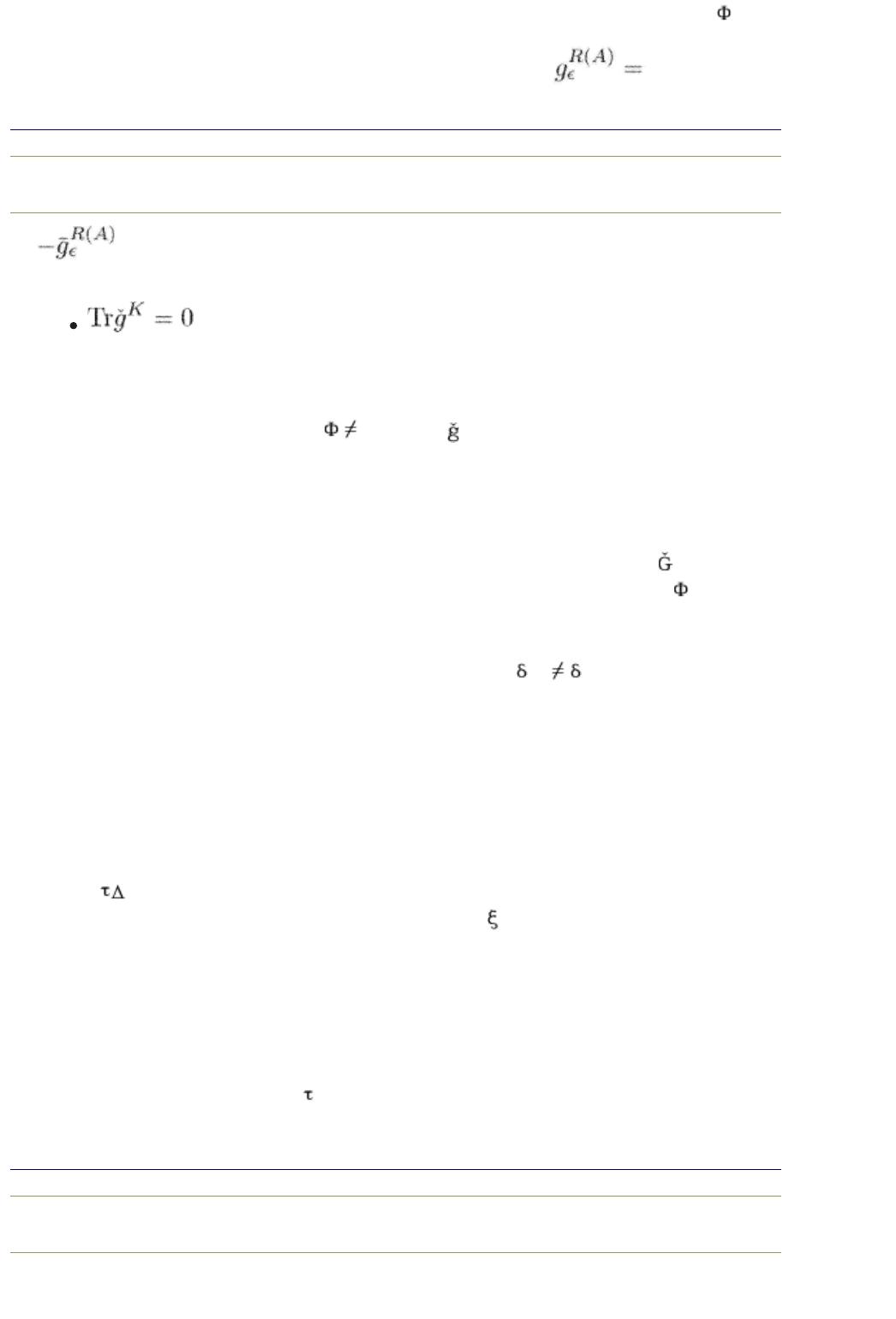
superconductor and/or near its border. A nonequilibrium state with a nonzero
is known as a state with the charge imbalance (Tinkham 1972). This terminology
comes from the following observation. In a static situation,
end p.227
which reflects the particle–hole symmetry. This causes, in particular,
that always
in a static case. This is the condition of a constant particle density: there are
exactly as many particle-like excitations as there are hole-like ones; moving an
electron from under the Fermi level to a position above it we do not create a new
particle. The situation changes if
0: now Tr
K
is nonzero if a special condition
on the chemical potential is not imposed. This means that the numbers of
particle-like and hole-like excitations are no longer equal. To keep the overall
particle density constant one needs to shift the chemical potential. This is called
the charge imbalance: the particle-like and the hole-like charges are not equal.
Of course, the overall charge density remains constant because we adjust the
chemical potential exactly in such a way as to maintain zero value of Tr
K
. This
effect is sometimes also called “branch mixing” because the relaxation of
is
associated with equalizing the populations of the particle-like and hole-like
branches of the excitation spectrum.
The process of relaxation of the charge imbalance with
µ
n
µ
s
is associated
with an exchange of particles between the normal part and the condensate in the
superconductor. Any process which facilitates the exchange contributes to the
relaxation. Inelastic processes are definitely the ones which work for such an
exchange. During an inelastic scattering event, the particle energy changes
together with the state of a given particle. It causes redistribution of particles
between the normal part and the condensate thus contributing to the charge
imbalance relaxation. This is why the electric field penetration length contains
the electron–phonon relaxation time in eqn (11.28). In the gapless regime, the
energy gap disappears, the exchange is very effective, and the only characteristic
time is
. The electric field penetration length squared is thus the diffusion
constant multiplied with this time which makes l
E
~ . The same happens during
the spin-flip scattering process because the energy of an electron in the order-
parameter field depends on its spin. In an s-wave superconductor, the scattering
by impurities will not cause the exchange because an elastic scattering does not
change the state of a particle if the energy gap is independent of the direction of
the particle momentum. However, if in the presence of a supercurrent, and/or for
a d-wave superconductor, the energy does depend on the momentum direction
and impurity scattering does change the state of a particle. This is why eqn
(11.45) determines l
E
through
imp
without characteristics of the inelastic
relaxation. For a more detailed discussion, see the book by Tinkham (1996).
end p.228
Part IV Vortex dynamics
PRINTED FROM OXFORD SCHOLARSHIP ONLINE (www.oxfordscholarship.com)
© Copyright Oxford University Press, 2003-2010. All Rights Reserved
PRINTED FROM OXFORD SCHOLARSHIP ONLINE (www.oxfordscholarship.com)
© Copyright Oxford University Press, 2003-2010. All Rights Reserved
Oxford Scholarship Online: Theory of Nonequilibrium Supe... http://www.oxfordscholarship.com/oso/private/content/phy...
第3页 共4页 2010-8-8 16:00

en
d
p.229
end p.230
Top
Privacy Policy and Legal Notice © Oxford University Press, 2003-2010. All rights reserved.
PRINTED FROM OXFORD SCHOLARSHIP ONLINE (www.oxfordscholarship.com)
© Copyright Oxford University Press, 2003-2010. All Rights Reserved
Oxford Scholarship Online: Theory of Nonequilibrium Supe... http://www.oxfordscholarship.com/oso/private/content/phy...
第4页 共4页 2010-8-8 16:00
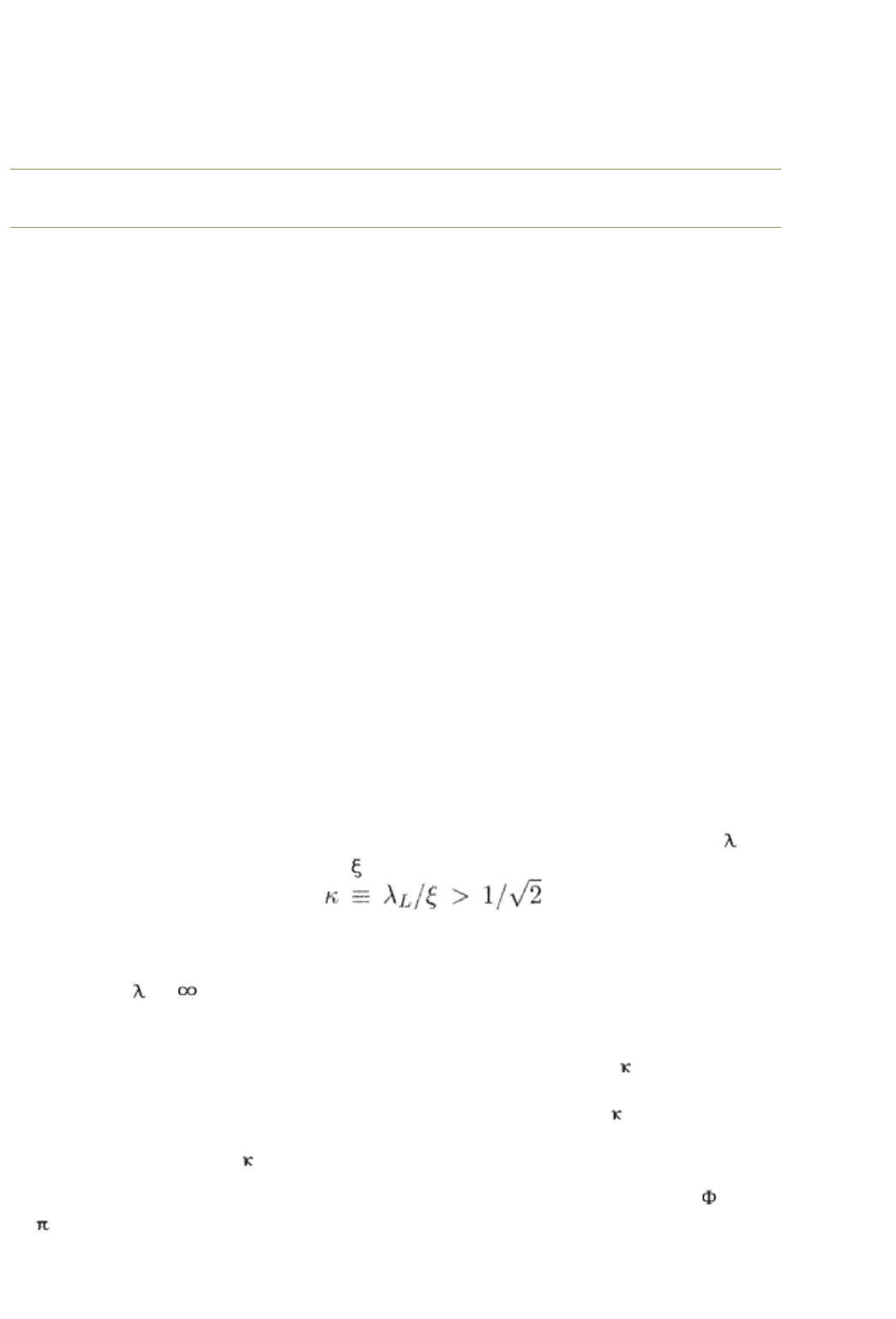
12 TIME-DEPENDENT GINZBURG–LANDAU ANALYSIS
Nikolai B. Kopnin
Abstract: This chapter considers vortex dynamics within the frameworks of the
conventional and generalized TDGL models. The forces (the Lorenz force and the
force from environment) acting on a moving vortex are identified and the force
balance is derived from the free energy considerations. The vortex viscosity and
the flux flow conductivity are calculated in the limits of rare (low fields) and
dense (high fields) vortex lattice for both s-wave and d-wave superconductors.
The flux flow conductivity for anisotropic and layered superconductors is also
calculated. A modification of the TDGL model is considered which allows one to
account for a small flux-flow Hall effect.
Keywords: vortex dynamics, vortex lattice, Lorenz force, vortex viscosity,
flux-flow conductivity, anisotropic superconductor, layered
superconductor, Hall effect
Vortex dynamics is considered within the framework of the TDGL model.
The balance of forces acting on a moving vortex is derived from the free
energy considerations. The vortex viscosity and the flux flow conductivity
are calculated. A modification of the TDGL model is considered which allows
us to account for the flux flow Hall effect.
12.1 Introduction
A very simple question that can arise in connection with the title of the present
part of the book is as follows. What is special in the vortex dynamics and why do
we want to study it? To answer this we note that the majority of known
superconductors are type II superconductors whose London penetration length
L
is longer than the coherence length . The exact condition which separates type
II from type I superconductors is
, see Section 1.1.2,
page 12. Almost all alloys and films made of conventional (low temperature)
superconducting materials are of type II. All known high-temperature and heavy-
Fermionic superconductors are also of type II. We can also mention superfluid
3
He where
L
= since particles which make Cooper pairs are uncharged. If we
place a type II superconductor in a magnetic field (or rotate superfluid
3
He)
vortices appear in the range of fields H
c1
< H < H
c2
, and the mixed state arises,
see Section 1.1.2. Since the lower critical magnetic field H
c1
~ H
c2
/
2
(see, for
example, de Gennes 1966, Saint-James et al. 1969), the mixed state exists in a
broad range of magnetic fields if the Ginzburg–Landau parameter
is
substantially larger than unity which is the case in high-temperature
superconductors where
can he as high as 100.
In superconductors, each vortex carries exactly one magnetic–flux quantum
0
=
c/|e|. Being magnetically active, vortices determine magnetic properties of
superconductors. In addition, they are mobile if the material is homogeneous and
there are no defects which can attract vortices and “pin” them somewhere in a
superconductor. In fact, a superconductor in the mixed state is not fully
Kopnin, Nikolai, Senior Scientist, Low Temperature Laboratory, Helsinki University of
Technology, and L.D. Landau Institute for Theoretical Physics, Moscow
Theory of Nonequilibrium Superconductivity
Print ISBN 9780198507888, 2001
pp. [231]-[235]
Oxford Scholarship Online: Theory of Nonequilibrium Supe... http://www.oxfordscholarship.com/oso/private/content/phy...
第1页 共7页 2010-8-8 16:01
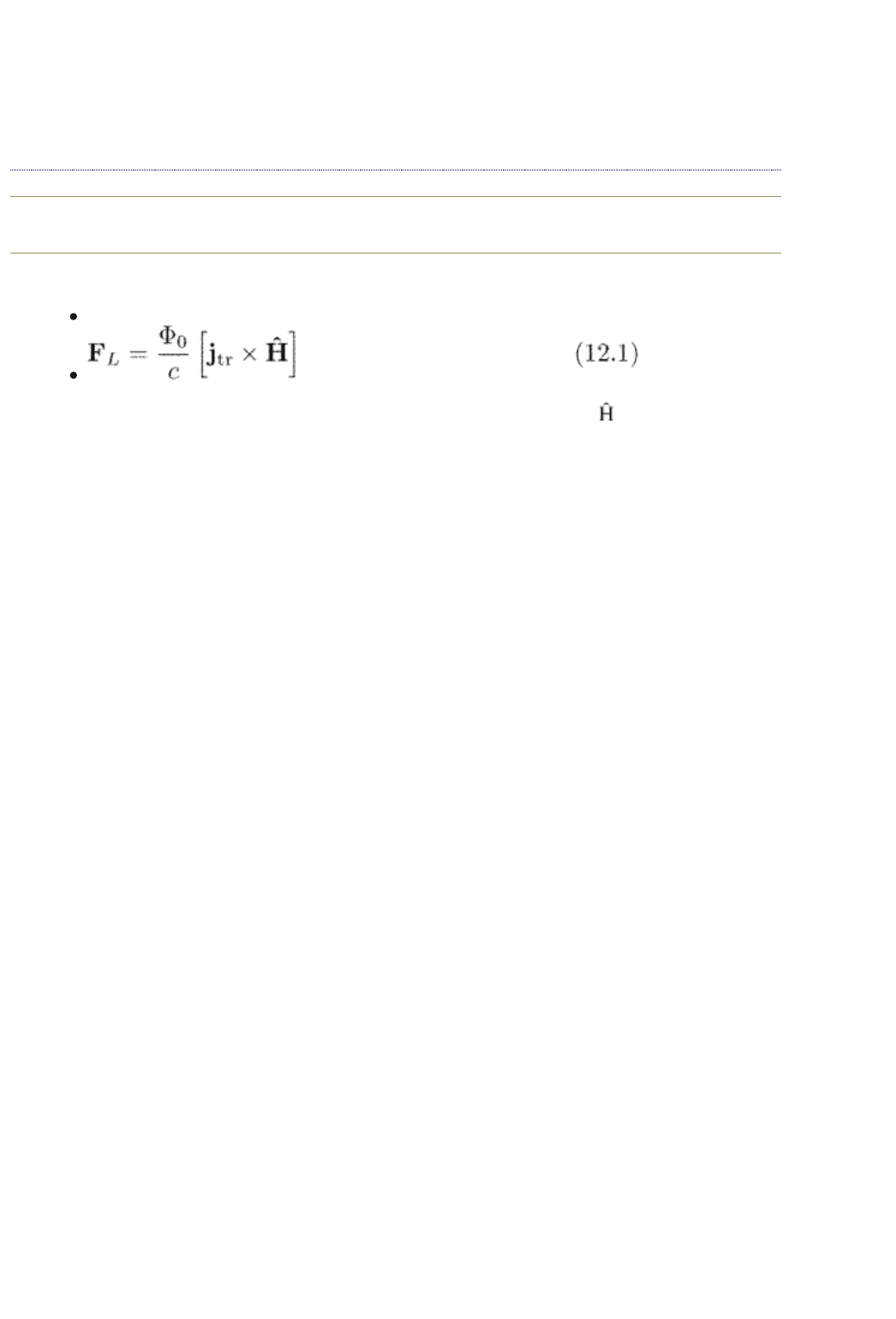
superconducting any more. Indeed, there is no complete Meissner effect: some
magnetic field penetrates into superconductor via vortices. In addition, regions
with the normal phase appear. Indeed, since the order parameter turns to zero at
the vortex axis (see Fig. 1.1) and is suppressed around each vortex axis within a
vortex core region of the order of the coherence length, a finite low-energy
density of states appears in the vortex cores. Moreover, mobile vortices move in
end p.231
the presence of an average (transport) current: the Lorentz force
(12.1)
pushes vortices in a direction perpendicular to the current (here is the unit
vector along the magnetic field). An electric field perpendicular to the vortex
velocity is generated by a moving flux, and a voltage appears across the
superconductor. Since vortices move at an angle to the transport current, there
may be components of the electric field both parallel and perpendicular to the
current. The longitudinal component produces dissipation in a superconductor
while the transverse one is responsible for the Hall effect. We see that a finite
resistivity appears (the so-called flux flow resistivity): a superconductor is no
longer “superconducting”! This is certainly an important effect.
The magnitude and direction of the vortex velocity is determined by a balance of
the Lorentz force and the forces acting on a moving vortex from the
environment. In the absence of pinning these forces include friction (longitudinal
with respect to the vortex velocity) and gyroscopic (transverse) forces (see Fig.
12.1). The friction force accounts for dissipation, i.e., for an effective longitudinal
or Ohmic “flux flow” conductivity while the transverse force determines the Hall
conductivity.
Experimental studies of flux flow effects began with the work by Kim et al.
(1965). Since then enormous efforts have been undertaken to find out and
understand the processes involved in the vortex dynamics and the vortex physics
in general. One now uses a notion of “vortex matter” to comprise all features
which vortices introduce to physics of superconductivity. We can mention the
reviews by Gor’kov and Kopnin (1975) and by Larkin and Ovchinnikov (1986)
which deal with the vortex dynamics, and a review by Blatter et al. (1994) which
contains many basic concepts of the vortex physics especially those which are
relevant to vortex lattices, vortex pinning, flux creep, etc.
In this part of the book, we concentrate on the theoretical description of the
vortex dynamics based on the microscopic theory of nonstationary
superconductivity. We consider the most representative examples among all
numerous situations studied by many researchers during several decades of
intensive work. We shall see that motion of vortices initiates almost all
nonequilibrium processes and involves all relaxation mechanisms which work in
superconductors. This is one more reason why it is important to understand the
vortex dynamics. We start with the simplest theory which uses the TDGL model.
The next chapter deals with more complicated physics in superconducting alloys
when nonequilibrium excitations come seriously into play. The last two chapters
describe the most interesting and intriguing phenomena in clean
superconductors, i.e., in those classes of materials which include, in particular,
new high-temperature superconductors. We do not consider effects associated
with the vortex pinning by random defects in a superconducting material
assuming that vortices are free to move in a homogeneous environment. An
PRINTED FROM OXFORD SCHOLARSHIP ONLINE (www.oxfordscholarship.com)
© Copyright Oxford University Press, 2003-2010. All Rights Reserved
Oxford Scholarship Online: Theory of Nonequilibrium Supe... http://www.oxfordscholarship.com/oso/private/content/phy...
第2页 共7页 2010-8-8 16:01
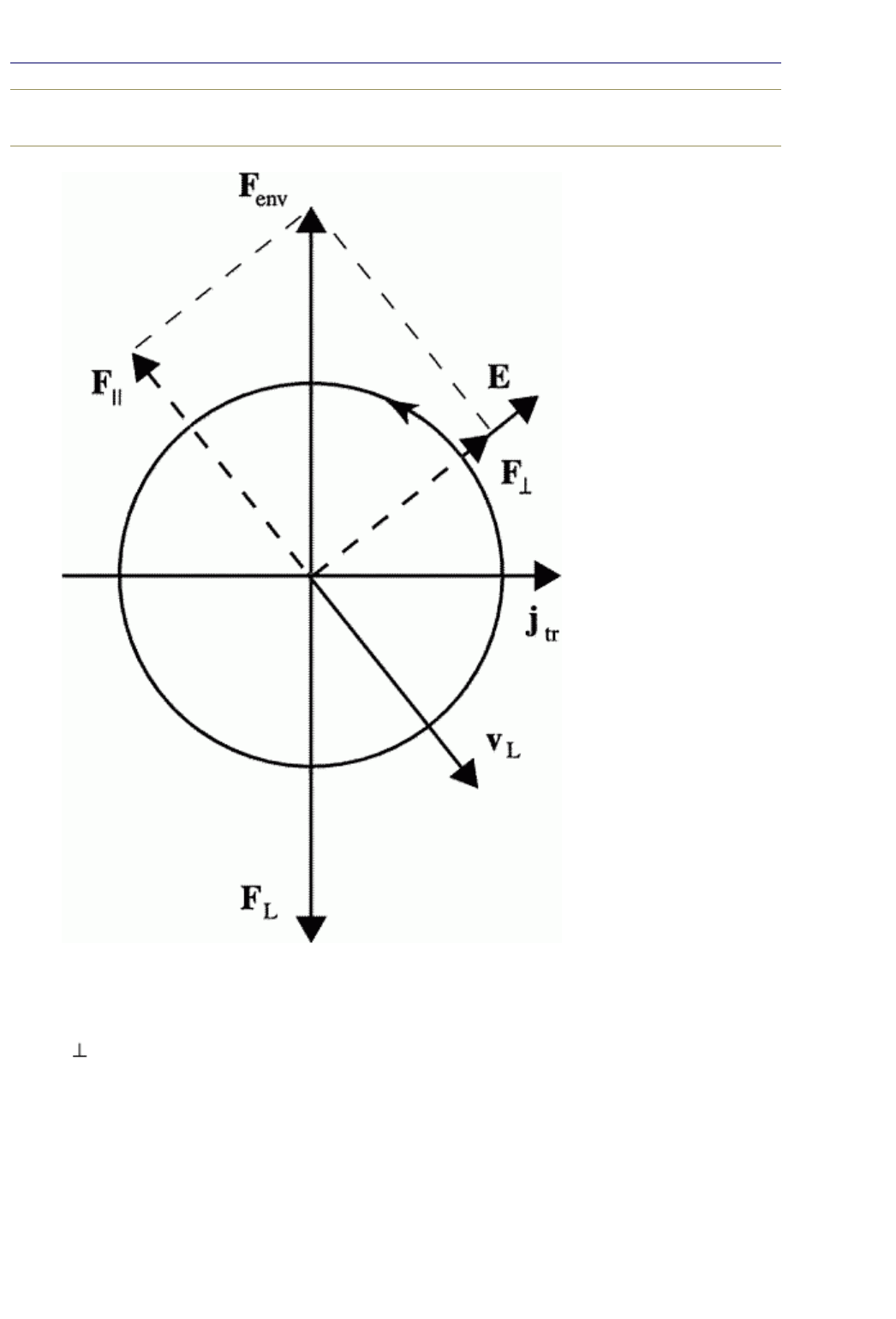
exception will be made for the intrinsic
end p.232
FIG. 12.1. Forces on a moving vortex: the Lorenz force from the
super current j
tr
is balanced by a force from environment F
env
.
The latter has the longitudinal (friction) F
||
and the transverse
F
components. The moving vortex generates an electric field E
perpendicular to the vortex velocity v
L
.
pinning when vortices interact with the regular crystal structure in layered
superconductors.
12.2 Energy balance
The TDGL model provides the simplest basis for dealing with nonstationary
processes in superconductors. Using it, one can establish quite general
relationships which are particularly useful for our goal of understanding the
PRINTED FROM OXFORD SCHOLARSHIP ONLINE (www.oxfordscholarship.com)
© Copyright Oxford University Press, 2003-2010. All Rights Reserved
Oxford Scholarship Online: Theory of Nonequilibrium Supe... http://www.oxfordscholarship.com/oso/private/content/phy...
第3页 共7页 2010-8-8 16:01
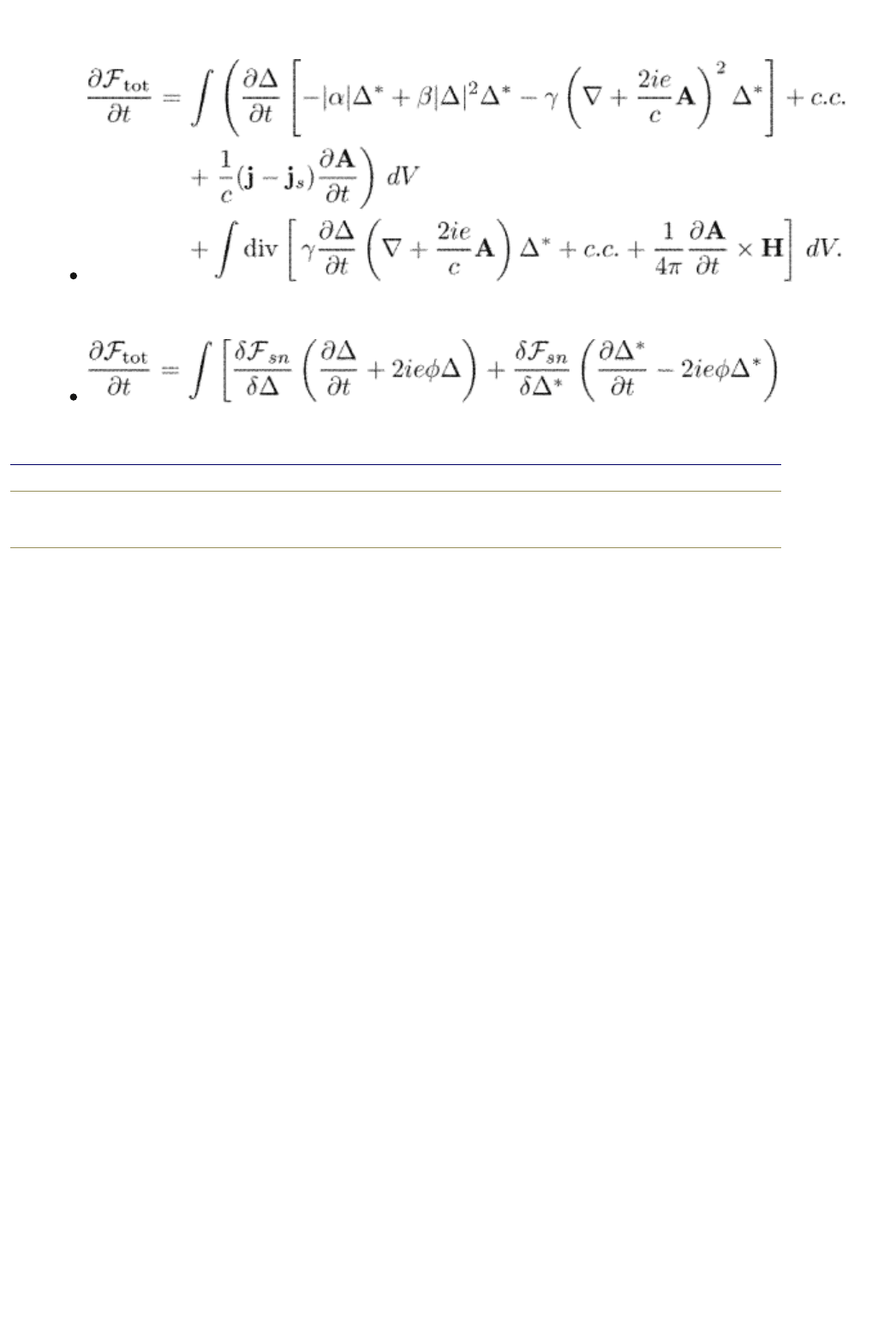
vortex dynamics. The first is the energy balance (Schmid 1966). Let us calculate
the time-derivative of the total GL free energy eqn (1.11). We have
With help of the TDGL equations (1.68) and (1.66) we obtain
end p.233
PRINTED FROM OXFORD SCHOLARSHIP ONLINE (www.oxfordscholarship.com)
© Copyright Oxford University Press, 2003-2010. All Rights Reserved
Oxford Scholarship Online: Theory of Nonequilibrium Supe... http://www.oxfordscholarship.com/oso/private/content/phy...
第4页 共7页 2010-8-8 16:01

We use eqn (1.76) to transform the second line. Since
we finally arrive at the free-energy balance equation
(12.2)
Here the free–energy current density is
(12.3)
and the dissipation function density has the form
(12.4)
One can identify two different terms in the dissipation function. The first contains
the time-derivative of the order parameter. It describes dissipation produced by
relaxation of the order parameter. The second is due to normal currents and is
similar to that in usual normal metals.
12.3 Moving vortex
Vortex moves when there is a transport current. j
tr
giving rise to the Lorentz
force eqn (12.1). We can calculate the flux flow conductivity
f
directly from the
dissipation function, putting it to
(12.5)
where E
L
is the electric field averaged over the vortex array. The average is
defined as
Oxford Scholarship Online: Theory of Nonequilibrium Supe... http://www.oxfordscholarship.com/oso/private/content/phy...
第5页 共7页 2010-8-8 16:01
